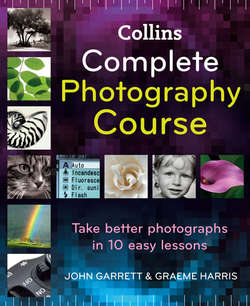Читать книгу Collins Complete Photography Course - John Garrett, Graeme Harris - Страница 27
Exposure
ОглавлениеThe two devices that the camera uses to make an exposure are the aperture and shutter. Working in tandem, they determine the amount of light that creates the image when you release the shutter.
The aperture
A camera lens contains an iris diaphragm, based on the functioning of the iris in an eye. It is constructed of metal leaves that open and close, making a bigger or smaller aperture in the lens through which light enters the camera. The aperture thus controls the volume of light that’s allowed to reach the film or sensor.
The size of the aperture is calculated in f-stops. Confusingly, the smallest number on your lens, such as f/2, is the largest aperture, and the highest number, perhaps f/16, is the smallest. The reason for this is that these numbers are actually fractions, representing the focal length of the lens divided by the diameter measurement of the aperture.
The shutter
Located in the camera just in front of the film or sensor, the shutter controls the length of time that either is exposed to the light entering through the aperture. The main shutter speed settings are in steps, each of which halves or doubles the length of the exposure; for example, 1/250 second allows half the amount of light through the lens as 1/125 second, while 1/60 second allows twice as much.
Modern cameras have a large range of exposure time settings, from 30 full seconds to 1/8000 second. There is also a setting called either B or Bulb, which keeps the shutter open for as long as the shutter release button is held down (you will need a cable release or remote control to keep the shutter open for an extended period). Shutter speeds on the dial are in fractions of a second until they reach 1” second, the symbol “ denoting full seconds.
Your camera has different shooting modes: S (single), which takes a single frame each time you press the shutter release and C (continuous), which is a built-in motor drive that can take up to 6 frames per second (depending on your shutter speed) while the shutter button is held down or until the film is finished or the card is full. This continuous mode can be great to use when you are panning or trying to capture a fast-moving subject. Some cameras offer the option of low and high speed continuous shooting (CL and CH respectively).
Shooting modes
All these aperture and shutter combinations have produced the same exposure for this picture. If either element of the combinations were to be changed the image would be brighter or darker.
1/250 second atf/4
1/125 second at f/5.6
1/60 second at f/8
1/30 second at f/11
1/15 second at f/16
The aperture and shutter function in relationship to each other, because in order to maintain what you or your meter calculate to be accurate exposure, both the volume of light entering through the aperture and the length of time the film or sensor is exposed to that light must be adjusted. If you increase the volume of light by enlarging the aperture, to maintain the same exposure you have to shorten the shutter speed.
Exposure meters
The exposure is calculated by your DSLR or SLR camera’s built-in exposure meter. When you compose a picture in your viewfinder, the meter analyses the light reflected off the subject and calculates what it considers to be a correct exposure of that subject.
When you are using the P, S and A modes at least part of the exposure is automatically made by the camera. In the case of M (manual), you have to set both the aperture and shutter yourself. Whether or not your photograph will be correctly exposed at the settings you have chosen is shown in the display in the viewfinder’s control panel so that you can adjust them if need be.
Although built-in meters in good-quality cameras are now very efficient, some photographers still prefer to use a separate handheld exposure meter. These use two methods of analysing the light and making exposure readings: like the camera’s meter, they measure the light reflecting off the subject, or they can measure the light falling on it, which is called an incident light reading.
When you are working with the exposure in M (manual) mode the exposure display in the control panel of the viewfinder shows if your picture is correctly exposed and, if not, whether you need to allow more or less light.
